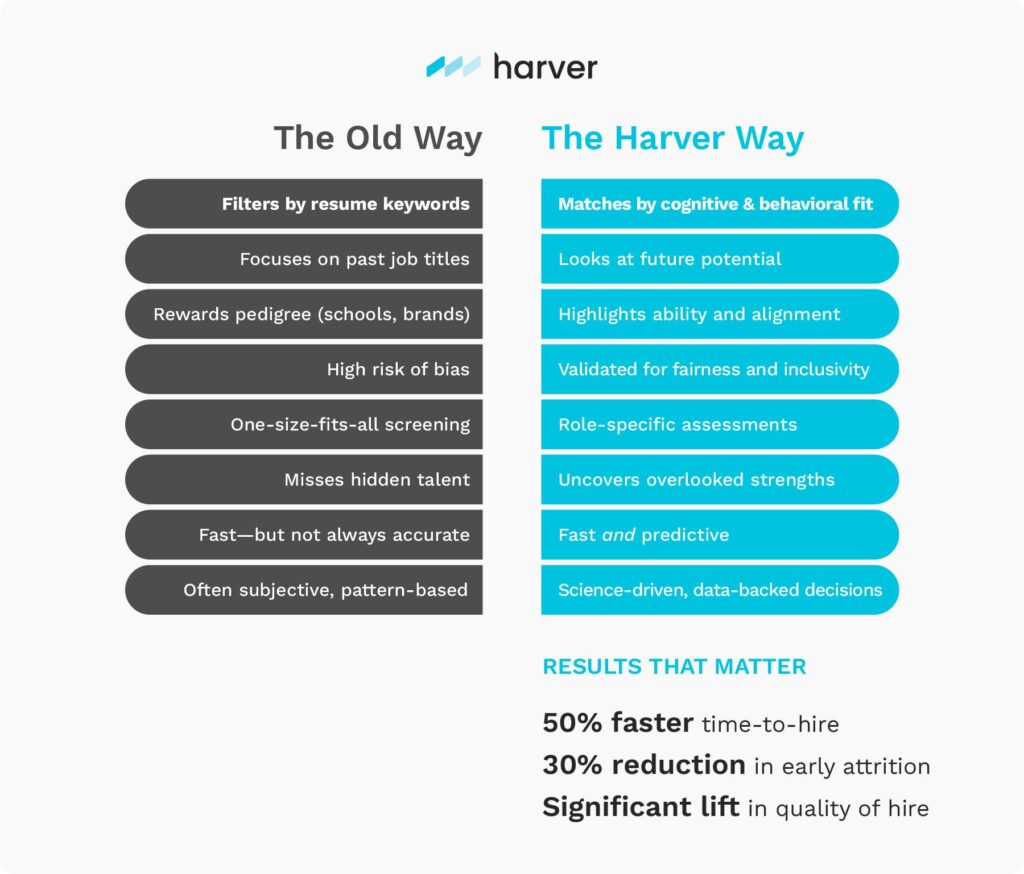Resume parsing has become a go-to tool for high-volume hiring—promising speed, automation, and efficiency. But there’s a problem: parsing resumes can only tell you where a candidate has been, not where they’re most likely to succeed.
In today’s workforce, experience isn’t always the best predictor of performance. Especially in frontline or high-turnover roles, resumes often miss the full picture—and worse, they can reinforce outdated ideas of what “qualified” looks like.
That’s why more companies are shifting toward predictive hiring—a science-based approach that looks beyond the resume to evaluate the traits that actually matter: learning agility, work style, cognitive fit, and long-term potential.
At Harver, we help organizations make that shift. Here’s why it matters—and how it leads to faster, fairer, and more effective hiring.
Resumes Reflect the Past. Harver Predicts the Future.
Resume data is static. It captures job titles, company names, and degrees—but none of the traits that actually drive success. According to our predictive hiring guide, these surface-level signals are often poor indicators of future performance, especially in early-career or hourly roles.
Harver’s platform goes beyond the resume, using science-based assessments to measure cognitive ability, personality traits, and behavioral preferences. These predictors help match people to jobs where they’re likely to thrive—resulting in smarter, faster hiring decisions and reduced turnover.

Stop Filling Jobs. Start Finding Fit.
Resume parsing is optimized for efficiency—not alignment. But hiring success doesn’t come from checking boxes. It comes from placing the right people in the right roles.
Harver’s assessments are designed to do just that. We evaluate candidate potential based on how well they match the real demands of a specific job—not what’s on their résumé. This is especially valuable in high-volume hiring environments where traditional screening methods break down.
For more on how predictive hiring changes the game, download our whitepaper on optimizing your hiring process.
Automation That Reduces Bias, Not Reinforces It
Here’s another issue with resume parsing: it can amplify bias by prioritizing prestige schools, familiar job titles, or branded companies—often at the expense of equally capable, but less traditional candidates.
Harver helps level the playing field. Our assessments are built to be inclusive, objective, and scientifically validated, ensuring that every candidate is evaluated on what matters: their potential to succeed.
To understand how this approach drives equity and performance, explore our whitepaper on predictive assessments in hiring.
Questions to Ask Yourself
Still relying on resume parsing to screen talent? Ask yourself:
- How confident are you that resume data alone gives you an accurate view of who will succeed?
- Have you seen drop-off from candidates without traditional backgrounds—but with real promise?
- What stands out in your best hires—their past experience, or how quickly they clicked in the role?
If these questions resonate, it may be time to reevaluate your tech stack. Our blog on the top trends transforming hiring in 2025 outlines how leading organizations are making that shift.
The Future of Hiring Is Predictive, Not Prescriptive
Hiring should be about more than parsing keywords or chasing credentials. It should be about understanding people—how they think, work, and grow—and using that understanding to match them to roles where they can thrive.
To see how this plays out in a full hiring strategy, check out Harver’s skills-based hiring solution—where we guide companies in evaluating candidates for the skills that matter most, building role-based skills models, and aligning assessment workflows with outcomes.
That’s what Harver delivers: data-driven hiring that reveals potential, reduces bias, and enables smarter decisions at scale.


